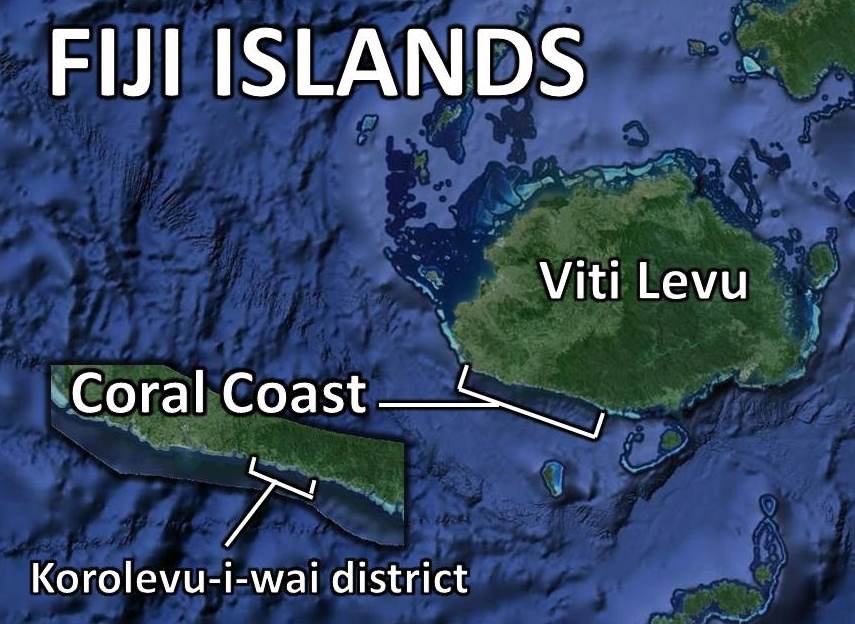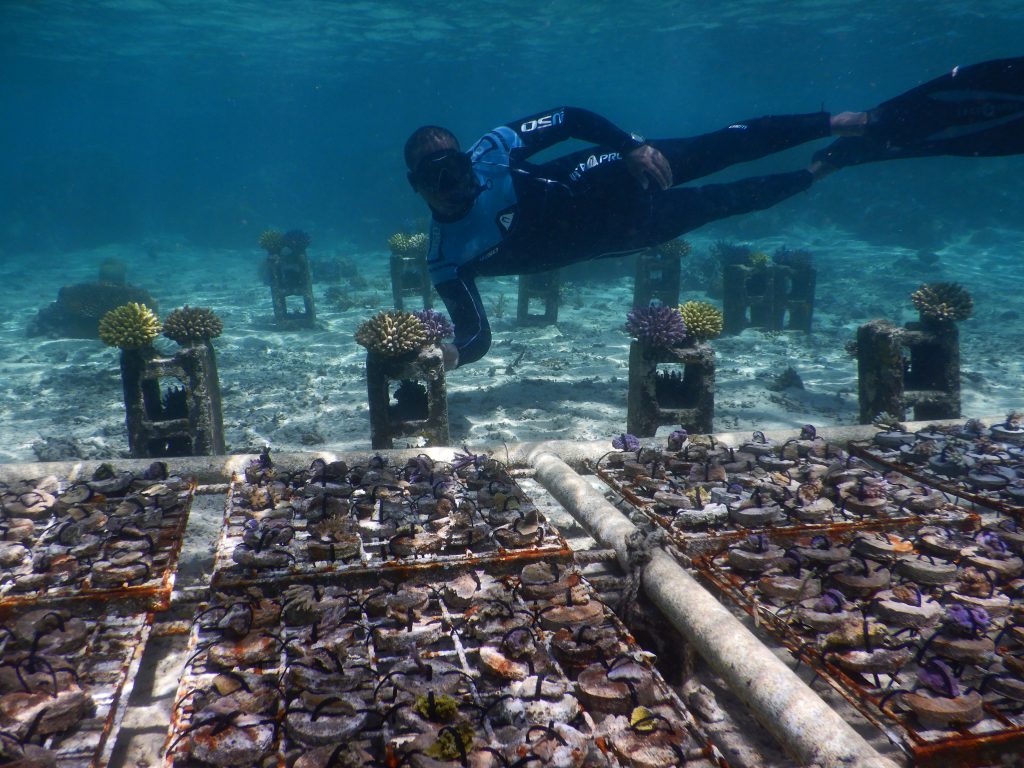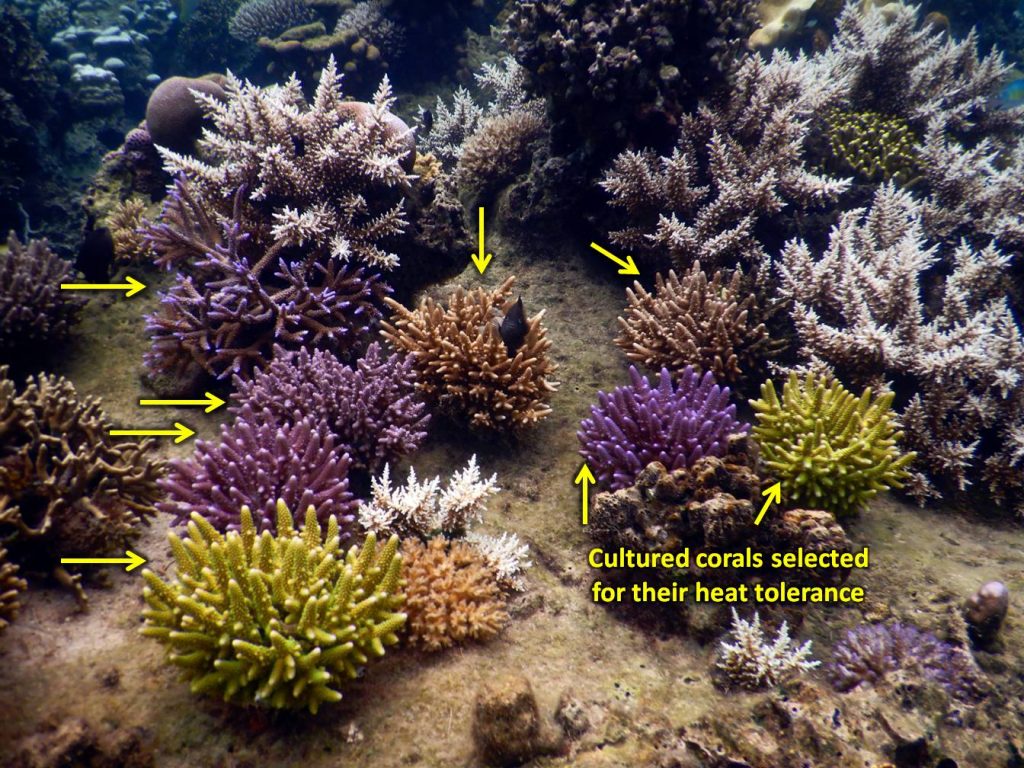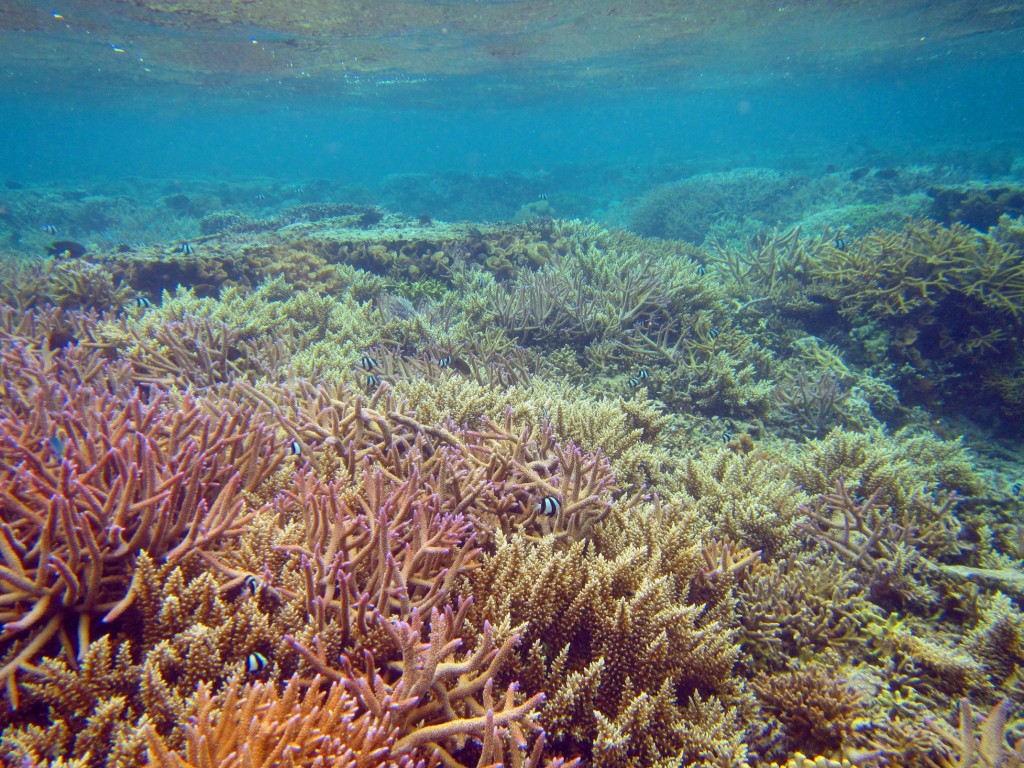Using Coral Restoration and Ecotourism to Increase Local Participation and Financial Benefits of Resource Management Efforts
Location
Korolevu-i-wai District, Baravi, Nadroga/Navosa, Fiji
Fiji’s Coral Coast – Southwestern Viti Levu
The project is being conducted in the Customary Fishing Ground of the Vanua Davutukia, in the Korolevu-i-wai District of Nadroga/Navosa Province, Fiji Islands
The challenge
Fiji’s coral reef ecosystem is the most extensive in the South Pacific and provides fisheries and tourism opportunities that are primary GDP earners and integral to the well-being, culture, and survival of Fijian communities. The southwest coast of Viti Levu, Fiji’s largest and most populated island, is flanked by the country’s longest fringing reef system and has been affectionately known as the Coral Coast since resort tourism began on its shores in the 1950’s. The wide, shallow lagoons filled with colorful fish and corals just meters beyond the white sandy beaches are the icon that made the Coral Coast famous and over the last 50 years has created a thriving tourism economy that today caters to more than 20% of Fiji’s tourists. Since time immemorial, these reefs have supported the subsistence needs of the indigenous resource owners. However, the spectacular reef ecosystem that became the icon of the Coral Coast has been degraded by the compounded effects of local impacts from high fishing pressure and coastal development along with climate change stressors threatening the backbone of the local economy and the livelihood and food security of coastal villages and settlements.

Location of Korolevu-i-wai district on the island of Viti Levu, the largest of 300+ islands in Fiji. Photo © Reef Explorer Fiji Ltd./Map from Google
The Korolevu-i-wai district is located in the heart of the Coral Coast and consists of the four traditional villages of Votua, Vatuolalai, Tagaqe, and Namada amongst which numerous settlements, residential areas, and tourism developments are interspersed. Overall, the district has a resident population of over 2,350 people living in more than 420 households, less than half of which are resource owners in the district. Along its shores lie numerous resorts and guest houses that offer over 450 guest rooms, largely on leased native land. The adjacent reef system is approximately 9km2 in area and is the Customary Fishing Ground of the Vanua Davutukia, the native resource owners of the district. The reef system is relied upon by most families in the district to meet their household food requirements, and is particularly depended upon when tourism arrivals and thus employment opportunities and income are down. In 2000, Fiji’s coral reefs suffered from the first-documented widespread, intensive bleaching event that resulted in extensive coral death. Korolevu-i-wai reefs lost much of their living coral with the shallow, backreef lagoon (where fishing and tourism activities mainly occur) being most severely impacted. Local impacts from overharvesting and other destructive fishing practices along with climate-related stressors have severely degraded the reef ecosystem to the point where coral communities have largely been unable to recover from the 2000 bleaching. The once majestic Korolevu-i-wai reefs now have <10% living coral cover, are largely overgrown with seaweeds, and the average catch for hook and line fishing is less than 200 gm of fish/person/hour.
Actions taken
The Vanua Davutukia of the Korolevu-i-wai district began with marine resource management efforts in 2002 with the support of the University of the South Pacific’s Institute of Applied Sciences (USP-IAS) and Fiji Locally-Managed Marine Areas (FLMMA) program. A simple, district-level resource management plan that identified perceived threats to the resources and mitigating actions to be taken was developed and adopted.

Korolevu-i-wai community-based marine management plan 2014-2019. No-take areas are outlined in red and orange and marked with the years they were established in, traditional villages are marked with stars and named, additional rules that apply for entire fishing ground are listed below, and the two bottom right photos show the traditional ceremony and offering to establish the management plan from 2014 to 2019. Photo © Reef Explorer Fiji Ltd.
In 2006, the Vanua Davutukia began working closely with Reef Explorer to implement and review their management plans and monitor the success of their activities. A suite of educational, research, and community development activities were undertaken to address priority issues along with extensive management planning activities and reviews of the community’s marine resource management plan in 2007 and again in 2014. The ultimate goal of the management plan is to bolster local incomes and traditions by replenishing and reviving local marine resources – a grassroots approach to rural development and conservation of natural resources. Management plans are developed via participatory techniques and include the establishment of community-based no-take marine protected areas (MPAs), fisheries enforcement and compliance activities, addressing pollution threats, enterprise development, and biological and socioeconomic monitoring for use in adaptive management of the community’s conservation and development activities. Some 6 to 10 years after their establishment, the MPAs had 500% more live coral cover and 50% greater species richness of coral than adjacent fished areas, little to no seaweeds, and 30% more food fish, 50% more species of food fish, and 500% more biomass of food fish than the adjacent fished areas (Technical Report).
The development of small-scale coral cultivation and restoration efforts is one of the activities that Reef Explorer has been assisting district villages with since 2006. This initiative began in village MPAs, largely as an educational and economic tool, but has evolved to become an integral and growing part of management activities, particularly as a climate change measure and to engage village youth in marine ecotourism and conservation.

We use disc nurseries at one of our shallow sites in order to propagate species of corals that can’t be easily grown on the ropes, such as corals that have encrusting or foliose growth forms. Cement discs are attached to mesh wire frames and then coral fragments are attached to the cement bases using pre-prepared cable ties. Photo © Reef Explorer Fiji Ltd.
As corals are a keystone species to the reef ecosystem providing essential habitat and otherwise supporting an amazing diversity of life, the restoration of coral communities is necessary for the recovery and resilience of local fisheries and the conservation of marine resources. With the assistance of village youth groups, coral nurseries established in four Korolevu-i-wai MPAs and one fished location were expanded and by 2016 a total of 7000+ new coral colonies were being propagated annually for use in restoration efforts.

Rope nurseries have been the easiest and most cost-effective method for propagating new corals of any species that have a branching morphology. Finger-sized fragments are inserted into the braided rope with each rope being stocked with corals that have similar growth rates. Photo © Reef Explorer Fiji Ltd.
Capitalizing on the success of MPAs in assisting the recovery of coral communities, coral colonies are asexually propagated from corals located in the MPAs through fragmentation of selected donor colonies or collection of unattached coral fragments. Selected donor colonies largely consist of heat-tolerant lineages of corals identified during previous coral bleaching events, but in some cases species that are rare at the sites are used as donors for fragments. Finger-sized fragments are grown out on ropes or cement discs in ‘coral nurseries’ until they are larger (6-10 months) and later transplanted back to the reef at restoration sites.

Once the coral fragments have grown larger (6-10 months) they are ready to be transplanted back onto the reef. First, they are cut apart with scissors to remove excess rope before being moved in baskets to the restoration site. Photo © Reef Explorer Fiji Ltd.
Areas of the reef that are lacking in living corals despite otherwise being suitable habitat are selected as restoration sites where propagated corals are transplanted. By assisting areas of the reef to recover in terms of coral cover and species richness using heat-tolerant coral lineages, coral restoration can be used as a climate adaptation strategy and play an important role in promoting the recovery of the coral communities necessary to support fisheries enhancement in these areas. By providing an attraction that can be used in local ecotourism enterprises, coral restoration can also help provide economic opportunities that reinforce the sustainable use and conservation of marine resources.

Our program has focused on working with heat-tolerant coral lineages that we have identified during thermal bleaching events. These 2018 transplants of heat-tolerant lineages of Acropora fruticosa are showing good thermal tolerance while other corals naturally occurring on the reef around them have already started to bleach during the 2019 hot season. Different lineages of the same species are planted in close proximity to each other to help promote successful reproduction with each other. Photo © Reef Explorer Fiji Ltd.
Generally, corals of the genus Acropora have been selected for propagation as they are fast growing and contribute greatly to the habitat complexity and overall coral species diversity found on healthy reefs. However, other coral genera (Porites, Montipora, Pocillopora, Stylophora, Seriatopora, Echinopora, Merulina, Hydnophora, and Psammocora) are being propagated as they are dominant genera in the reef community, can be used to help secure and consolidate substrate, and/or are resilient to thermal stress and less affected by crown-of-thorns starfish predation. In total, multiple lineages of more than 50 species of hard corals are used in the restoration efforts.

Our transplanting strategy consists of creating mixed species assemblages across available hard bottom area. In these patches, different lineages of the same species are planted in close proximity to each other to help promote successful reproduction with each other during spawning months. In combination with the careful selection process for donor colonies, this strategy can not only increase coral cover with more resilient corals, but also bolster the reproductive success of these heat-tolerant lineages. Photo © Reef Explorer Fiji Ltd.
Corals are most commonly transplanted onto the reef substrate using a mix of cement and plaster. Corals are transplanted in mixed species assemblages at the restoration sites in an aim to improve the survivorship and the reproductive success of these heat-tolerant lineages of corals. Propagated corals are also being used for research examining heat tolerance and the reproductive ecology of corals.

As we generally work in high-energy environments, corals need to be fixed in place in order to reattach themselves to the reef. Our preferred method for doing this is to use a mixture of cement, plaster, and fine beach sand while the tide is low and water movement is limited. The mixture is made into balls, placed on brushed substrate, and new corals placed partially on the cement. Photo © Reef Explorer Fiji Ltd.
In conjunction with the establishment of the coral nurseries, youth groups are being assisted by Reef Explorer to develop plans and capacity for operating snorkeling tours of the coral nurseries and restoration sites in their respective MPAs. Currently, snorkeling tours are operated by youth in two of the four villages providing employment and financial benefits to the villages.
How successful has it been?
Since 2006, 50,000+ corals consisting of more than 50 species have been propagated and transplanted back to the reef in village MPAs, and village youth have received basic training in cost-effective coral propagation techniques, reef ecology and fauna, and integrating this work into guided snorkeling tours.

Corals are reattached to hard bottom substrate areas that are well-grazed, remain submerged during low tides, and otherwise are in a suitable environment for coral growth. Generally, 2-4 corals are attached per 1 m2 of reef area depending on what corals already exist on the bottom. Photo © Reef Explorer Fiji Ltd.
As the coral restoration work has progressed, a variety of international guests have visited specifically to learn from or observe the project and assist with coral transplanting efforts including the Governor of Tokyo, Locally-Managed Marine Area (LMMA) country representatives from all Asia-Pacific member countries, Fiji government and NGO representatives, Fijian students, American and Australian Travel agents, study abroad programs from U.S. and Australia-based universities, and numerous international conservation practitioners and marine educators from around the Caribbean and Pacific. Guest visits have provided thousands of dollars of income to village funds, village youth, and have been used to further develop coral restoration efforts. Additionally, the propagation technique was adopted by American researchers for several years providing further income generating opportunities for the local community through the preparation for and propagation of corals for use in experiments.

A reef area and overturned coral heads that have been restored with transplanted corals. Photo © Reef Explorer Fiji Ltd.
This coral restoration program serves as a pilot effort for other communities to learn from and has resulted in improved local marine management capacity and compliance, and ecotourism strategies. These efforts have brought thousands of dollars into the hands of villagers and supported the continuation and expansion of coral planting efforts and capacity building for snorkeling guides. Overall, coral restoration activities have enhanced local marine conservation efforts by:
- Providing economic incentives for conservation;
- Bolstering participation of village youth in marine conservation efforts;
- Improving local knowledge of coral life history and reef ecology through ‘hands-on learning’;
- Further integrating community-based resource management efforts with Fiji’s growing tourism industry; and
- Helping coral communities re-establish and adapt to increasing sea water temperatures so as to support local fisheries and coral community resilience.
Lessons learned and recommendations
Key lessons learned from the coral restoration efforts over the last 13 years include:
- Simple asexual coral propagation methods can be quickly learned and effectively implemented by community members for coral restoration efforts.
- Corals in the genus Acropora, though often utilized in restoration efforts, have been those that are most susceptible to disease and predator damage. Propagating a variety of genera intermixed throughout the nursery helps reduce predation and improves overall success.
- Restoration efforts are much more effective and successful in well-established no-take areas, areas with good water quality conditions, and/or reef areas with healthy herbivore populations.
- Strong local governance and community support and participation are critical to the success of coral reef management and restoration efforts. Involving village youth in the efforts along with community leaders and elders promotes compliance and sustainability of the outcomes.
- Economic incentives foster greater community support for and participation in coral reef management.
- Combining coral restoration with income-generating activities such as snorkeling tours can improve community interest in coral restoration and conservation activities while providing financial support for the effort.
Funding summary
Until 2015, funds to support coral restoration efforts have been provided by Reef Explorer through the facilitation of associated educational tourism and research programs. A one-year grant from the Sylvia Earle Alliance – Mission Blue in May 2015, the PADI Foundation in 2016, and sponsorship by Hakuto Life Science in 2017, 2018, and 2019 provided for the expansion and maintenance of coral restoration activities in the Korolevu-i-wai District. Additional funds are being sought to support the implementation of associated educational, research, and ecotourism development activities as well as to engage with youth groups in adjacent districts.
Lead organizations
Reef Explorer (Fiji) Ltd. – contact Victor Bonito – staghorncoral@hotmail.com
The Coral Coast Conservation Center
Vanua Davutukia of Korolevu-i-wai (indigenous resource owners)
Partners
University of the South Pacific, Institute of Applied Sciences (co-management partner)
Resources
Sylvia Earle Alliance – Mission Blue
It Takes a Village: In Fiji, saving coral reefs is a community affair




